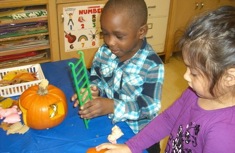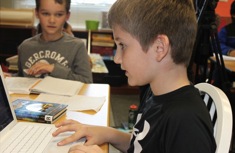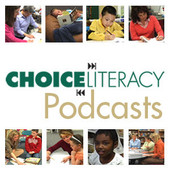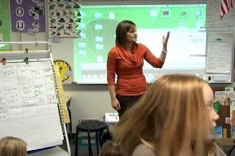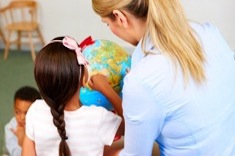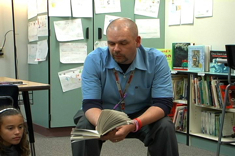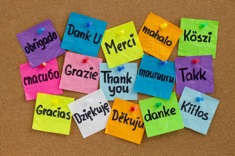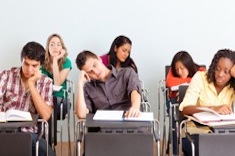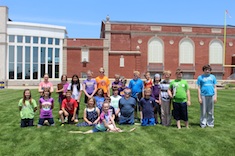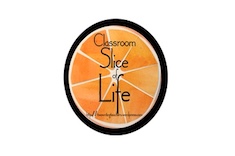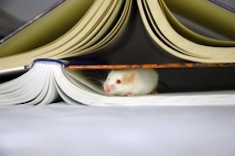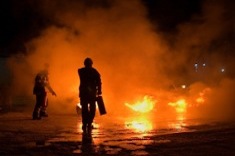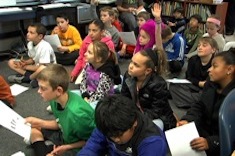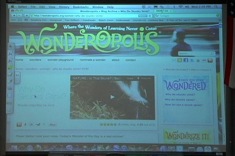Community Building
It's one of the big paradoxes of literacy instruction - students best learn how to read and write independently when they have a strong community of support in classrooms. How teachers build those thoughtful, kind, and challenging classroom communities is explained in these resources.
Latest Content
Pumpkin Time: Provocations and Stories with Preschoolers
Kelly Petrin reinvents a pumpkin decorating project with her preschoolers to help them build storytelling skills.
Using Technology to Connect Young Readers and Writers
Julie Johnson reflects on how technology is changing her own reading community, and builds on this knowledge to connect readers and writers in her classroom with others through the Internet.
Global Read Aloud with Pernille Ripp (PODCAST)
Franki Sibberson chats with Pernille Ripp about the Global Read Aloud initiative.
Transition Tool: “Come On Over”
This video is a quick take from Katie DiCesare’s first-grade classroom, showing how she uses the tune “Come On Over” as a transition tool.
“My Ideal Bookshelf”: Books that Educate Us
Ellie Gilbert shares an activity that is a terrific way to get to know your new students. Although Ellie works with high school students, this activity can be adapted for the younger grades.
Routines to Build Independence Early in the School Year
Katie DiCesare explores how to develop routines early in the year, and includes advice to give to parents to build the home/school connection around expectations for independence.
First Read Alouds (ROUND-UP)
Choice Literacy contributors share their picks for the first read aloud of the year.
New Teachers: The Power of Inexperience
Sometimes a lack of experience is a gift worth embracing. Michelle Kelly considers all the strengths new teachers bring to schools, from their comfort with technology to genuine enthusiasm.
Planning a Read Aloud Sequence to Launch the School Year
Tony Keefer shares the three essential questions that guide his process of selecting first read alouds.
Whole Group Writing Share
Franki Sibberson’s fourth graders use the whole-class writing share time to discuss writing series they are working on (including blog interviews and book reviews), with an eye toward collaborating with classmates.
Are You Excited About Next Year?
Kelly Petrin finds a bare classroom at the end of the year leads her to improvise with stuffed animals and literacy with her preschool students. The mix of play and reading is so successful that it changes her planning for the fall.
Using Instagram to Sell Summer Reading Options
Tony Keefer taps into the Instagram craze among his students, and finds it is an ingenious tool for encouraging summer reading while kids are on vacation.
Grateful Journals
Beth Lawson began her own gratitude journal as a troubled teen, and finds that the daily routine of Grateful Journals is a powerful tool for reflection and building community in the intermediate grades.
Teacher Resume
Even if you have no plans to apply for a new job anytime soon, creating a resume can be a wonderful catalyst for defining who you are and what you value. It’s also a great document to share with parents and new students. Amanda Adrian explains its creative uses.
Conferring with Ben
Franki Sibberson confers with Ben, a fourth-grade writer trying to figure out the best audience for his writing when technology presents many options.
Staying Connected with Students All Summer Long
Cathy Mere explains how she uses technology to stay in touch with students and families over the summer.
The Cure for Senioritis? Poetry!
There may be a group of students somewhere less eager to learn than a class of high school seniors during the last weeks of school, but that group would be as tough to find as Bigfoot or the Loch Ness monster. Gretchen Schroeder discovers a surprising cure for senioritis —modern poetry.
Conferring with Pierce
Franki Sibberson demonstrates how much ground can be covered in a three-minute conference with a student. She helps fourth grader Pierce think through the audience for his writing, how to add visuals to blog posts, and enlists him to teach others new skills as he acquires them.
Football Field Writing
Katherine Sokolowski adapts an idea from Jim Burke to get her fifth graders outdoors and envisioning their growth over the summer.
Madness, the Spring Slump, and High School Readers
Are your adolescent readers present in body but not necessarily in spirit by springtime? We've featured the "book madness" bracket activity in the past for elementary students. Gretchen Schroeder finds the ranking, competition, and passionate discussion about favorite books is just what her high school students need to get their heads back in the reading game.
The Lunch Lady and Gender in Reading
Franki Sibberson has her students read a blog post about books written for boys and girls, which begins a fascinating discussion with the class about gender in reading choices.
Slice of Life: Challenging Student Writers
Katherine Sokolowski brings the popular web “slice of life” challenge to her fifth-grade classroom.
Every Picture Tells a Story
Max Brand describes how he uses images to build reading and writing skills among his kindergartners.
Family Literacy Night
Family Literacy Nights have become popular in many schools. Principal Jennifer Schwanke describes the format for a successful event, including a sample program and tips.
Tips for Effective Family Communication from “The Mouse”
Jennifer Vincent details strategies and shares survey templates she uses in reaching out to families.
Hindsight: What I Wish I’d Known Before My School Burned Down
Melanie Quinn shares lessons from the fire that burned down her school.
March Book Madness
Basketball’s March Madness has many possibilities in schools. Tony Keefer tries a similar format with brackets and voting for March Book Madness.
Science Challenge
Franki Sibberson’s fourth-grade students share results from the weekly science challenge.
Getting More from Wonderopolis
Franki Sibberson uses Wonderopolis with her 4th grade students, helping them learn to research and dig more deeply at the site.
Supporting the Transition to Middle School: An Elementary Teacher’s Perspective
Maria Caplin shares how and why she began to collaborate with Gretchen Taylor, a sixth-grade teacher who would soon be the middle school teacher for some of her students.
Browse Content By
Type
Category
- Assessment Tools
- Big Fresh Archives
- Booklists
- Choice Numeracy
- Classroom Design
- Common Core
- Community Building
- Conferring
- Content Literacy
- Digital Literacy
- English Language Learners
- Equity
- Family Relations
- Free Samples
- Guiding Groups
- Leadership
- Literacy Coaches
- Mentor Texts
- Minilessons
- New Teacher Mentors
- Podcasts
- Poetry
- Quote Collections
- Reading Strategies
- Self Care
- Struggling and Striving Learners
- Talking and Listening
- Teacher Study Groups
- Teaching Reading
- Teaching Writing
- Word Study and Vocabulary
Author
- Melissa Quimby
- Nawal Qarooni
- Gwen Blumberg
- Julie Cox
- The Lead Learners
- Hannah Tills
- Josie Stewart
- Ruth Metcalfe
- Mallory Messenger
- Becca Burk
- Jodie Bailey
- Vivian Chen
- Mary Brower
- Tiffany Abbott Fuller
- Stephanie Affinito
- Ruth Ayres
- Leigh Anne Eck
- Heather Fisher
- Shari Frost
- Julie Johnson
- Suzy Kaback
- Gigi McAllister
- Shirl McPhillips
- Melanie Meehan
- Cathy Mere
- Debbie Miller
- Tara Barnett and Kate Mills
- Tammy Mulligan
- Dana Murphy
- Bitsy Parks
- David Pittman
- Brenda Power
- Heather Rader
- Matt Renwick
- Mandy Robek
- Christy Rush-Levine
- Gretchen Schroeder
- Jen Schwanke
- Brian Sepe
- Katherine Sokolowski
- Stella Villalba
- Jennifer Vincent
Grade Level
Choice Literacy Membership
Articles
Get full access to all Choice Literacy article content
Videos
Get full access to all Choice Literacy video content
Courses
Access Choice Literacy course curriculum and training

